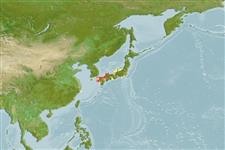Teleostei (teleosts) >
Perciformes/Scorpaenoidei (Scorpionfishes) >
Aploactinidae (Velvetfishes)
Eponymy: Ichiro Kaneko provided Tanaka with fish specimens from Nagasaki, Japan, including the holotype of Kanekonia florida. We have not been able to find further details about him. (Ref. 128868), visit book page.
More on author: Tanaka.
Environment: milieu / climate zone / depth range / distribution range
Ecology
Marine; demersal; depth range 20 - 30 m. Temperate
Western Pacific: known only from Japan.
Size / Weight / Age
Maturity: Lm ? range ? - ? cm
Max length : 4.6 cm SL male/unsexed; (Ref. 8937)
Dorsal spines (total): 11 - 13; Dorsal soft rays (total): 8 - 10; Anal spines: 1; Anal soft rays: 8. Body somewhat slender and compressed. Cheek and body sparsely covered with soft papillae. Preoperculum with 4 blunt spines. Teeth on prevomer; none on palatine. Anterior part of dorsal fin higher. Body creamy white in preserved specimen. Attains 4.5 cm SL.
Life cycle and mating behavior
Maturity | Reproduction | Spawning | Eggs | Fecundity | Larvae
Poss, S.G., 1982. A new aploactinid fish of the genus Kanekonia from Indonesia and redescription of K. florida. Jap. J. Ichthyol. 28(4):375-380. (Ref. 8937)
IUCN Red List Status (Ref. 130435: Version 2024-1)
Threat to humans
Harmless
Human uses
Fisheries: of no interest
Tools
Special reports
Download XML
Internet sources
Estimates based on models
Phylogenetic diversity index (Ref.
82804): PD
50 = 0.6250 [Uniqueness, from 0.5 = low to 2.0 = high].
Bayesian length-weight: a=0.00537 (0.00215 - 0.01342), b=3.14 (2.92 - 3.36), in cm total length, based on LWR estimates for this (Sub)family-body shape (Ref.
93245).
Trophic level (Ref.
69278): 3.3 ±0.3 se; based on size and trophs of closest relatives
Fishing Vulnerability (Ref.
59153): Low vulnerability (10 of 100).
